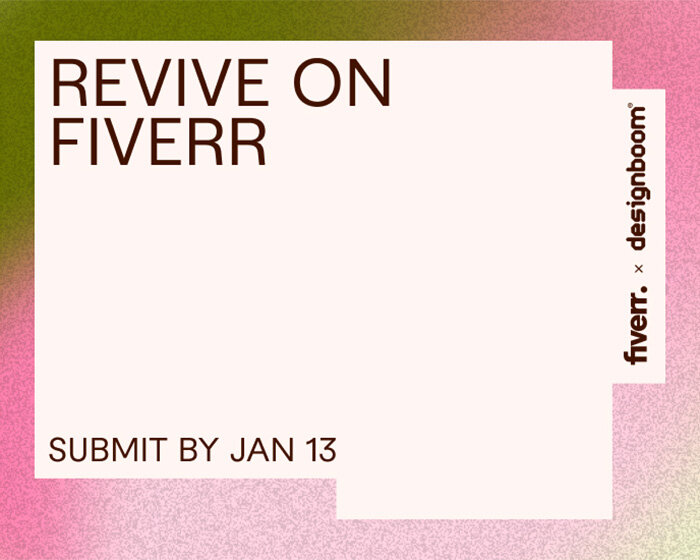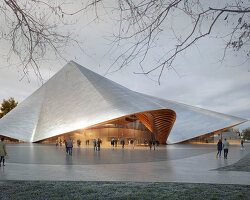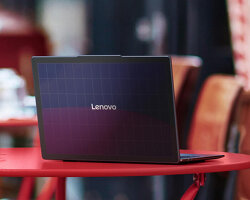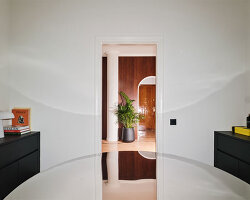BIG reveals winning ‘Solar Cupola’
Bjarke Ingels Group / BIG has won a competition to design a new European Commission research center in Seville, Spain. The winning scheme features a ‘cloud’ of stepped photovoltaic panels inspired by Seville’s shaded plazas and streets. Bjarke Ingels says, ‘With our design for the Joint Research Centre in Seville, more than anything, we have attempted to allow the sustainable performance of the building to drive an architectural aesthetic that not only makes the building perform better but also makes it more inhabitable and more beautiful – a new Andalusian environmental vernacular.’
Ingels continues,‘Having started my studies as an architect in Andalusia and later returning to ETSAB in Barcelona, to now having a 50-person BIG office in Barcelona, this project feels like coming full circle’.
Named ‘Solar Cupola’, the new building is being developed for the Joint Research Centre (JRC), the European Commission’s science and knowledge service. The 9,900 sqm program includes 12 research units and supporting functions as well as public and private outdoor spaces. Construction is expected to begin in 2024.

image by BIG-Bjarke Ingels Group
The Joint Research Centre will be realized on the former Sevilla Expo ´92 site in Isla de la Cartuja. BIG’s scheme includes covering the entire site with square solar canopies made of lightweight photovoltaic sheets supported by a forest of slender columns. This unifying roofscape will shelter the plaza, garden, and research building underneath, akin to the pergolas typical to Seville. The roof cascades down from the center of the site to a human scale height at its periphery creating a variety of public spaces underneath it.
Underneath, the building is positioned diagonally across the site to connect the Joint Research Centre directly to the ‘Jardin Americano’ riverfront and the Torre Sevilla market in a seamless continuous public space that is both plaza and promenade. Placing the building diagonally also creates a new public square on one side of the building and a private garden for the JRC community on the other.

image by Playtime
The floorplates of the research center step back as the building ascends, creating a series of terraces, shaded outdoor spaces for breakouts, relaxation, and informal meetings with views of the city.
‘When we visited the site in Seville last year and carefully reviewed JRC’s ambitious goals, we realized the potential to not only meet but exceed the requirements of the new JRC by creating a new breed of building – one that could become a beacon for sustainability, the future of public space and work environment – a single system tailored to Seville’s social and physical vernacular,’ explains Joao Albuquerque, Partner at BIG Barcelona.

image by Playtime
Inside, the public program and amenities such as dining, a conference center and social spaces are located on the first floor while the offices and research units occupy the upper floors for privacy and security. The collaborative workplaces face the plaza, while the deep-focus workspaces face the garden. The proposed layout is designed by BIG to be entirely flexible and adaptable according to any future needs of the JRC.
Following the building geometry and modularity two diagonal voids connect all levels of the building, encouraging physical movement as well as social interaction and informal meetings. JRC staff and visitors will be more likely to take the stairs, increasing the chance of meetings and encounters between colleagues.

image by BIG-Bjarke Ingels Group
The passive design of the building through its shallow floorplate and constant shading under the pergola cloud enables natural cross ventilation and ideal light qualities, reducing the energy consumption typically used on artificial lightening, air conditioning and mechanical ventilation.
The design prioritizes locally sourced materials, such as limestone, wood, and ceramic tiling. The building structure is low-carbon concrete, reducing up to 30% of typical CO2 emissions, while the pergola cloud is made from recycled steel. Gardens, greenery from the region, and water elements in the outdoor environment seek to reduce/eliminate the heat island effect and create a comfortable microclimate.

image by Fusao
The research center ties into the City of Sevilla’s goal to become a global benchmark for sustainability by 2025 and the local vision of the eCitySevilla project to decarbonize and transition Isla de la Cartuja to 100% renewable energy sources. The development also aims to deliver on JRC’s commitment to sustainability, unite the European vision of the New Bauhaus initiative, and establish a new benchmark for workspace that empowers knowledge sharing, collaboration and co-creation.
‘We are extremely excited to announce this incredible design for the new JRC site in Seville as we launch the New European Bauhaus Lab,’ says JRC Director General Stephen Quest. ‘The ‘NEB Lab’ aims to create enabling conditions for the green transition and drive tangible transformation on the ground. The new building for the JRC Seville site is the ideal opportunity for us to ‘walk the talk’. The future building will be one of the first examples of architecture entirely inspired by the values of the New European Bauhaus, while achieving maximum energy efficiency and life cycle sustainability, an issue of outmost importance today.’

image by BIG-Bjarke Ingels Group

image by BIG-Bjarke Ingels Group










project info:
name: JRC Sevilla
location: Seville, Spain
client: Joint Research Centre, European Commission
architecture: Bjarke Ingels Group / BIG
collaborators: Buro Happold (MEP & Structural Engineering & Sustainability), HCP Architecture & Engineering (Local Architect), Grupo Argenia (Local MEP), Play-Time & Fusao (Visuals)
partners-in-charge: Bjarke Ingels, João Albuquerque
project leader: Stefani Fachini de Araujo
project manager: Angel Barreno Gutiérrez
team: Hanna Ida Johansson, Nir Leshem, Gonzalo Coronado, Jose Carbonell, Miquel Perez, Luca Fabbri, Matthew Reger, Elena Ceribelli, Pietro Saccardi, Raphaël Logan, Saina Abdollahzadeh
BIG landscape: Giulia Frittolic
gross floor area: 9,900 sqm



























